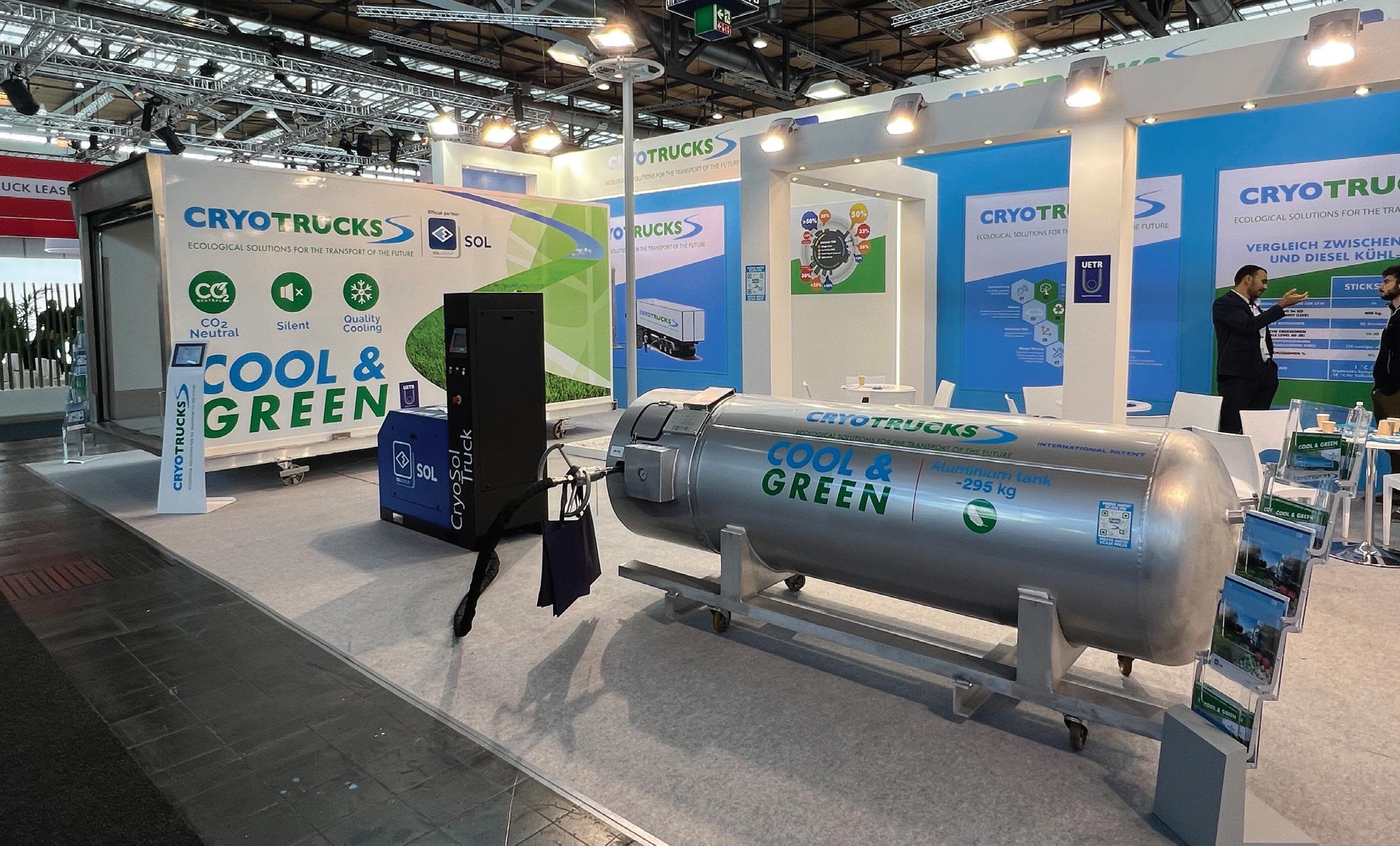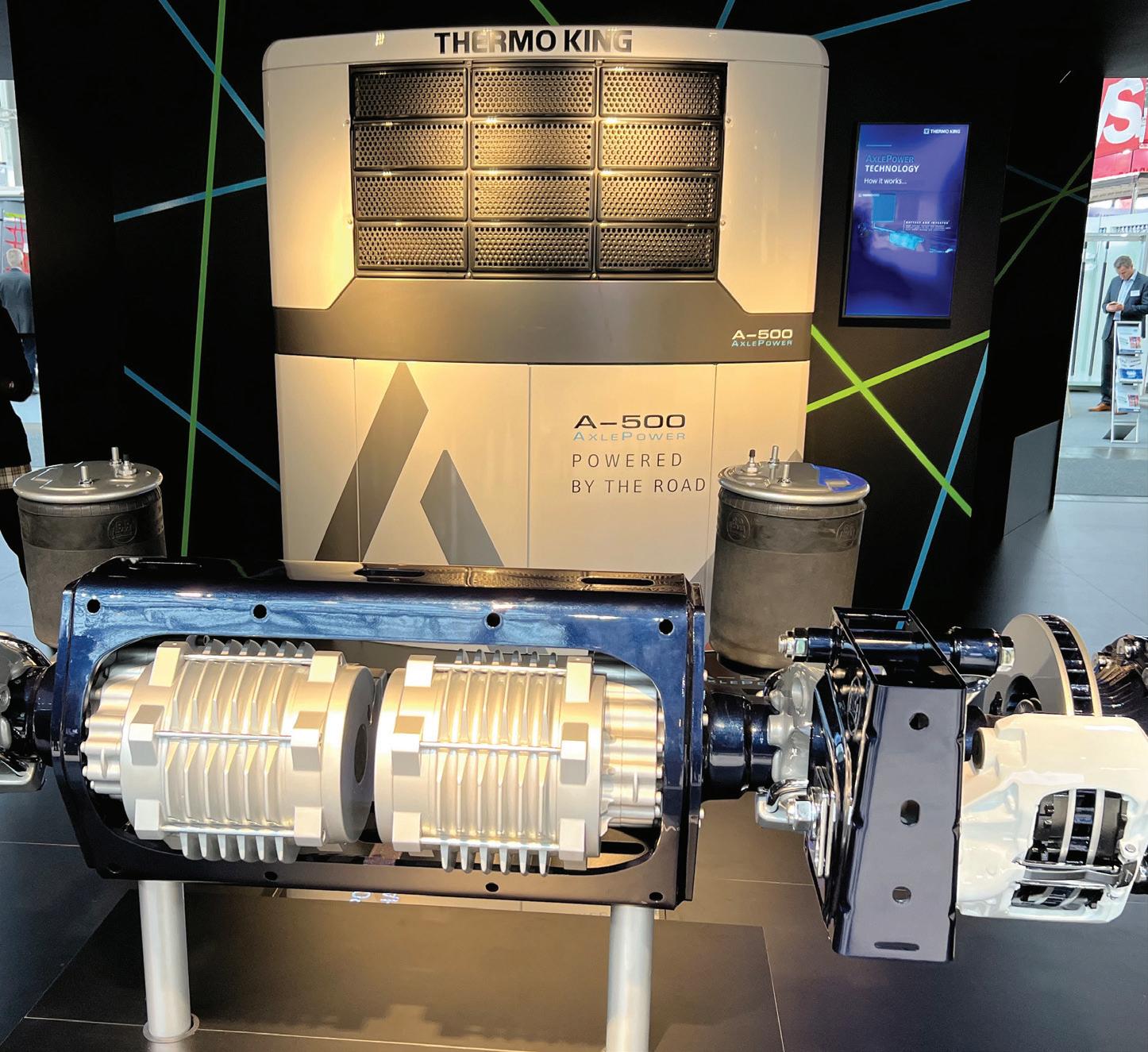
7 minute read
Refrigerated trucks
from FORS Standard Autumn 2022
by CVMP
Words: Richard Simpson
RED TURNS GREEN FOR REFRIGERATED TRUCKS
Fridges powered by donkey engines have been the mainstay of temperature-controlled road transport since its inception, but alternative power sources are now coming to the fore. Here we explain why – and what’s available
Last April saw the UK Government ban the use of duty-rebated ‘red’ diesel/gasoil in almost every application except agriculture. For the cold-chain sector, this accelerated a transition away from independently powered refrigeration that was already being driven by concerns about noise and emissions from small diesel engines. Several doubtful myths had been allowed to take hold – one being that such engines had unregulated emissions and another that they were in constant operation. But the phaseout of red diesel provided a compelling argument for the development of alternative power sources.
Broadly speaking, there are three means of powering mobile refrigeration: eutectic, kinetic and parasitic. The first uses ‘cold’ created off the vehicle, then stored and released on it. The second uses the motion of the vehicle, particularly in over-run, to charge a battery to power the fridge and the third uses the truck’s engine itself,
Below: Cyrotrucks showed a mocked-up nitrogen refuelling system at IAA
imposing a small additional load but with only marginal increases in fuel consumption and emissions. Each has its own advantages and disadvantages. We’ll look at examples of each and their application in the heavy transport market, together with what the future might hold.
Below: The Thermo King/BPW system is unique in having two axle-mounted generators Eutectics Carrier Transicold’s VATNA is a eutectic system. Plates containing R404A refrigerant gas are cooled at night using off-peak electricity to compress and as the gas expands, their cooling is used to preserve loads at below freezing during the day. It’s cheap, simple and efficient but lacks the controllability and endurance of more sophisticated systems.
Cryotrucks uses liquid nitrogen produced from the atmosphere as a by-product of industrial oxygen manufacture carried in a tank on the vehicle. This is released into an evaporator where it absorbs heat from the load compartment before being returned to the outside atmosphere. Units weigh from 175 to 250 kg and have outputs from 7,000 to 1,800 W. Nitrogen tanks with volumes from 420 to 990 litres and weights from 210 to 320 kg must be added to the equation. The units will last from one to three days on a single fill and can support up to 20 door openings a day. Unopened, temperature can be maintained for up to a week. Cryotrucks claims temperature pull-downs to –20C can be twice as fast as conventional systems.
The expansion of warming liquid nitrogen can also used to power a conventional reciprocating engine in place of a diesel, with the added bonus that the resultant non-toxic exhaust gas can also be used to cool the load in the manner of the Cryotrucks product.
This concept was pioneered by the now-defunct Dearman Engine Company, but is still being developed by Clean Cold Power UK Ltd, based, as Dearman was, in Croydon.

Kinetics Here the motion of the vehicle, particularly under braking, is used to power a generator that charges a battery that powers the fridge. It’s a sector that has seen a tremendous amount of development in recent years, but the first unit, using an SAF axle with generator incorporated to power a Carrier Transcold fridge, was actually shown 10 years ago.
Improvements in battery technology, driven by developments for batteryelectric vehicles, are making this technology increasingly attractive.
Schmitz Cargobull, which is unique as a trailer-maker for manufacturing its own axles and refrigeration units, now offers an in-house kinetic solution.
Control electronics occupy the space taken by the engine on a conventional unit, the battery takes the place of the fuel-tank between the landing legs and a wheel-driven generator is installed on the left-hand side of the trailer’s middle axle. This is carefully controlled to minimise parasitic drag: for instance, it automatically deactivates when the truck is pulling away and activates when the truck is in over-run condition and there is capacity in the battery to take the charge, or at speeds of over 70 km/h where rolling resistance is less significant than aerodynamic drag.
The battery can also be charged via a conventional ‘shore-power’ link at the depot and can provide four to five hours of refrigeration unsupported by the onboard generator.
Operational trials with a German supermarket indicate a fuel penalty for the tractor unit of one litre/100km, but a saving of two litres over the same distance from the fridge. The weight
penalty is only 80kg over a conventional trailer with a full fuel tank, but the upfront cost premium is €35,000.
Other fridge and axle manufacturers have co-operated to produce similar solutions, including BPW/ThermoKing and Valx/Carrier: both of which displayed at the CV Show in Birmingham this year. The BPW axle is unique in having regen units operating on each wheel-end of the axle to give symmetric retardation. Standard trailer tyres are specified.
Parasitic With the end of the red diesel rebate, using the truck’s own engine to power the fridge starts to make sense from an economic as well as environmental viewpoint. Most truck engines produce a surplus of power that can be diverted to drive a generator most of the time and their emissions-control systems operate better the harder the engine is working.
Carrier offers an Eco-Drive power module powered from the truck’s PTO and featuring a hydraulically driven generator which in turn powers the fridge, with output independent of engine speed.
Hultsteins claims users of its PTOdriven Ecofridge can save around 2,520 litres of diesel a year against a conventionally driven fridge. Ecofridge units can be installed between the cab and body, under the chassis, or in the conventional position on the front wall of the body above the cab.
Operators looking to ‘green’ an existing fleet of fridge trailers and future-proof their tractor fleets can fit Hultstien’s Ecogen system.
This can be installed on any tractor with a PTO on the back of the engine and generates a 400-volt, three-phase supply that can be fed to any compatible trailer fridge unit to eliminate donkey engine running time while the tractor engine is running. Renault, Scania and Volvo trucks have a suitable DIN port for a PTO as a factory-fitment on their engines and other makes can be equipped with one as either a line-fit option on a new truck or retro-fitted to existing vehicles.
As an alternative to a PTO, ThermoKing can offer a hybrid solution, with an additional, liquid-cooled, FrigoBlock alternator mounted on the front of the truck engine to power the fridge through an inverter as an alternative to running the fridge’s own engine. An additional bracket to support the belt-driven alternator needs to be installed on the front of the engine and space found for installation of the inverter. Above: Schmitz Cargobull claims net savings of one litre per 100 km from its kinetic system


Left: Carrier Eco-Drive hydraulic generator runs off the truck’s PTO
Future challenges The introduction of battery-electric trucks presents opportunities and challenges for the refrigeration industry. Providing a so-called ePTO powered by the electric truck’s traction batteries is an obvious solution and ZF already offers a suitable product, but it may compromise range too much for some operations. Much depends on the journey profile: if there is plenty of opportunity for the truck to replenish its batteries – either by recharging at loading/unloading points during the journey or by running downhill in the latter part of the trip – then range may remain acceptable.
Long term, hydrogen will probably be an increasingly viable alternative to battery electrics in the heavy truck sector. At the recent IAA Show, Carrier displayed a concept fridge unit powered by a hydrogen fuel cell.
The complete system uses a Bosch fuel cell to convert hydrogen into electricity to power a Vector e-Drive fridge and it could run from the hydrogen carried on either a fuel cell or hydrogen combustion engine powered truck. The fuel cell is only one tenth the size of a typical truck fuel cell and the entire system can be contained in a package of comparable size to one of today’s dieselelectric fridges. ■









